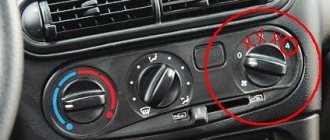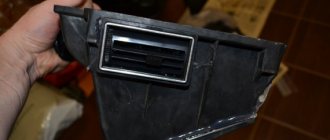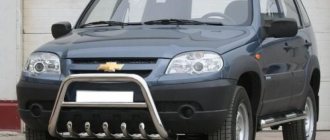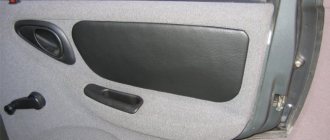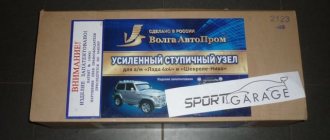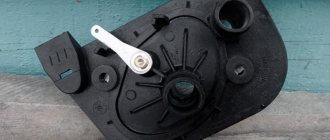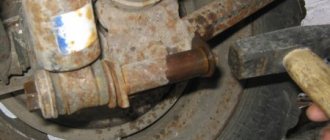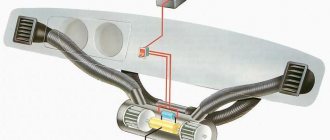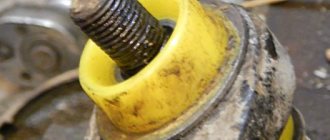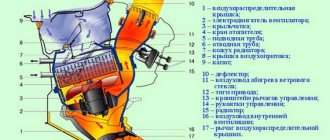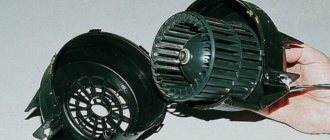07/17/2021 6,365 VAZ Chevrolet Niva
Author: Ivan Baranov
With the onset of cold weather, it is important that the car interior is heated, creating comfortable conditions for the driver and passengers. The article discusses cases when the stove of a Niva Chevrolet car does not work, the main malfunctions, and describes how to repair the unit.
[Hide]
How the heater and cooling fan works in Niva Chevrolet
The movement of air through the heater radiator is carried out by a DC motor . The impeller is installed directly on the rotor shaft, which minimizes power losses. The fan electric motor is securely mounted in a sealed casing, which is located under the windshield of the car, so to repair it, you will need to remove some interior elements.
Attention! The maximum impeller speed can reach 3000 rpm, but only if the original electric motor model is installed.
The operation of the electric heater motor is controlled from inside the car using a special switch.
Additional resistor
To ensure a comfortable temperature inside the car, it is not always necessary to operate the fan motor at full power. To reduce the speed, additional resistance is installed in series in the electrical circuit . This simple but effective method can significantly reduce the intensity of the air flow.
For more precise adjustment, the resistor has 3 resistance values , and given the possibility of direct connection, the rotation of the motor rotor can be set in 4 different speed modes.
The standard product provides the following current indicators , which is directed to the electric motor after passing through the internal spiral of the limiter:
- 5.1 A – first speed.
- 9.0 A – second.
- 14.0 A – third.
Attention! Depending on the type of motor installed, the maximum current at fourth speed can range from 18 to 25 Amps.
The heater fan does not work on a Niva Chevrolet: photos and videos
The standard stove on a Chevrolet Niva, in principle, rarely requires repairs and heats properly, but over time the quality of conveyor components began to decline. Therefore, the heater began to exhibit childhood illnesses, which, one way or another, lead to failure of operation. An electric heater motor with peripheral equipment can create a number of surprises, and we will talk about them today.
How does the Niva Chevrolet heater fan work?
Like any automobile electric motor, the heater fan on the Chevrolet Niva is a DC commutator motor with the ability to stepwise adjust the speed. A motor with catalog number 2123-8118020 with a removable impeller on bushings is installed on the conveyor ; however, there is an alternative to it on floating bearings from the Luzar company with catalog number lFh-01211 ; there is a similar bearing motor from the Boutler company.
The stock engine can reach a peak of 3000 rpm , while the analogs spin up to a maximum of 2750 rpm . The maximum current consumption for the Luzarov motor is 25 A , for the native one - about 18 A.
Heater motor luzar lfh-01211 12V/14A.
The difference is significant, since the heater motor circuit is protected by fuse F18 rated 25 A.
Additional resistor
The operation of the electric motor in four modes is ensured by an additional resistor , which often causes various malfunctions. Its catalog number is 2111.8101012 or 2123-8118022-01 .
Additional resistor 2123-8118022-01.
At the first speed, the engine should consume no more than 5.1A , at the second and third 9 and 14A, respectively. At the maximum, fourth rotation speed , the voltage is supplied bypassing the resistor. Actually, all possible culprits for the malfunction of the air supply to the cabin are indicated; it’s time to name the symptoms of the malfunction.
Symptoms of a problem
The simplest situation is when the electric motor does not spin at all. In this case, there may be several reasons :
- Failure of fuse No. 18 rated 25 A.
It only protects the heater motor circuit. Check fuse F18. - Break, short circuit, damage to the motor winding.
- Lack of contacts on the motor power supply block, damage to the wiring.
- Damage, freezing or wear of the electric motor brushes.
- There is no voltage at the output contacts of the speed switch, the switch is broken.
In these situations, everything is simple - change the fuse, clean the contacts and check the wiring. In the case of damaged or worn brushes, you will have to completely remove the stove fan.
Connection diagram for the electric motor of the heater fan and the rear window heating element: 1 – ignition switch; 2 – mounting block; 3 – heater motor switch; 4 – additional resistor; 5 – heater electric motor; 6 – rear window heating element; 7 – switch for heated rear window with control lamp; A – to power supplies; K6 – additional relay; K7 – relay for turning on the heated rear window.
Stove fan repair
It is more difficult when the engine spins, but does not develop sufficient speed . This is dangerous because when the rotation of the electric motor shaft is difficult, it consumes much more current, so the fuse may burn out and the winding may fail. Diagnosing a fault in this case requires some experience and the breakdown may not be immediately detected, but a blown fuse will make it clear that there are problems with the motor.
The engine armature may not gain speed due to a dirty, oxidized or worn commutator or worn brushes.
In addition, insufficient motor speed can be caused by an interturn short circuit in the armature winding or wear or clogging of bushings or bearings . It is also possible that the cabin filter is clogged. In the case of bearings or bushings, the engine will make noise during operation, and the noise will increase over time. This can be treated either by replacing the motor, or by lubricating or replacing bushings or bearings.
The cause of increased noise from the stove may be clogged bearings and bushings that need to be lubricated.
Symptoms of a problem
Malfunctions of the interior heating fan will be especially noticeable in the winter season. Failure of this system can be manifested by a complete lack of rotation of the electric motor, constant operation of the motor at maximum speed, or periodic turning on of the device. Regardless of the cause of the malfunction, replacing the Niva Chevrolet heater fan or repairing it can be done with your own hands.
Heater and cooling fan repair
If the motor winding is burned out, then only experienced craftsmen can do the rewinding themselves at home . If the motor completely fails, you will need to purchase an original product or its equivalent.
Replacement of the electric motor is carried out on your own or at a service station. If repairing the electrical system of a car is being done for the first time, you should strictly follow the step-by-step instructions, and also carefully monitor the correct connection of the wires.
Attention! It is not recommended to use used engines for replacement, because it is quite difficult to accurately assess their condition.
What kind of malfunctions can there be?
If the engine is working properly, but the cooling fan is not working, then this condition of the ventilation and heating system may be caused by a simple wiring break. In this case, a thorough visual inspection is carried out while simultaneously testing the electrical circuit with a tester.
Sometimes a malfunction of the cooling and heating system manifests itself in the constant rotation of the fan motor at maximum speed. Despite the apparent insignificance of such a breakdown, it can lead to an excessive increase in temperature in the cabin.
In addition, operating the stove in this mode produces the maximum noise level, which also creates discomfort. The reason for this “behavior” of the ventilation and heating system may be a malfunction of the additional resistor. Replacing this element allows you to completely eliminate the damage.
What to do if the Chevrolet Niva heater fan does not work: causes and troubleshooting
The fan of the Niva Chevrolet car interior heating system is the most important component of the car. Even with a working radiator, the heater will not work properly if there is no air movement. When the Niva Chevrolet heater fan does not work, the cause of the breakdown should be sought not only in the electric motor, but also in the electrical wiring switching devices. This article will discuss in detail the main symptoms of this type of malfunction, as well as how to eliminate them.
How the heater and cooling fan works in Niva Chevrolet
The movement of air through the heater radiator is carried out by a DC motor . The impeller is installed directly on the rotor shaft, which minimizes power losses. The fan electric motor is securely mounted in a sealed casing, which is located under the windshield of the car, so to repair it, you will need to remove some interior elements.
Attention! The maximum impeller speed can reach 3000 rpm, but only if the original electric motor model is installed.
The operation of the electric heater motor is controlled from inside the car using a special switch.
Heater and cooling fan repair
If the motor winding is burned out, then only experienced craftsmen can do the rewinding themselves at home . If the motor completely fails, you will need to purchase an original product or its equivalent.
Replacement of the electric motor is carried out on your own or at a service station. If repairing the electrical system of a car is being done for the first time, you should strictly follow the step-by-step instructions, and also carefully monitor the correct connection of the wires.
Attention! It is not recommended to use used engines for replacement, because it is quite difficult to accurately assess their condition.
What kind of malfunctions can there be?
If the engine is working properly, but the cooling fan is not working, then this condition of the ventilation and heating system may be caused by a simple wiring break. In this case, a thorough visual inspection is carried out while simultaneously testing the electrical circuit with a tester.
Sometimes a malfunction of the cooling and heating system manifests itself in the constant rotation of the fan motor at maximum speed. Despite the apparent insignificance of such a breakdown, it can lead to an excessive increase in temperature in the cabin.
In addition, operating the stove in this mode produces the maximum noise level, which also creates discomfort. The reason for this “behavior” of the ventilation and heating system may be a malfunction of the additional resistor. Replacing this element allows you to completely eliminate the damage.
DIY troubleshooting
If the Chevy Niva cooling fan does not turn on, then if you have at least a little experience, you can try to fix the problem yourself. The main advantage of repairs without the involvement of third-party specialists is saving money and time . Also, during the work, other elements and devices that are located at the location of the stove can be checked.
The disadvantages of self-repair may include making serious mistakes , which will lead to failure of not only the products being repaired, but also related parts. In some cases, replacing parts may result in a short circuit and fire in the vehicle.
If, despite all the possible disadvantages, you decide to repair the Chevrolet Niva yourself, then the recommendations below will help minimize the risks and possible damage from unprofessional intervention in the electrical system of the car.
Step-by-step instruction
If the stove fan does not turn on, then first you should check the fuse , which is responsible for the safety of the wiring circuit of this electricity consumer. The Chevrolet Niva relay and fuse mounting block is located under the steering column. To get to it, you will need to unscrew the screws and remove the cover by pulling it towards you.
The location of the fuses inside the block may vary significantly depending on the car model, but in both old and restyled models, the protective device located in cell F18 is responsible for the heater heater. Such a product must operate at a current strength of more than 25 Amperes. You can check the functionality of the fuse with a tester or multimeter.
Attention! When installing a high-power fan motor (25A), the standard fuse is replaced with a product with a response current of 30 Amps.
If the fuse is in good condition, it is possible that the heater fan malfunction is caused by a failed electric motor. To make sure that this part has actually burned out, you will need to dismantle it.
This work is performed in the following sequence:
- Remove the glove compartment. To perform this operation, you will need to unscrew several screws, remove the cover stops and the side casing.
- Unscrew the screws securing the electric motor.
- Disconnect the wires.
- Open the hood and remove the windshield wipers and the panel underneath them.
- Remove the cabin filter.
- Unscrew the four nuts holding the air duct box in place.
- Remove the engine from the engine compartment side.
You can check the electric motor using a multimeter, or by directly connecting it to a 12 V current source. If the motor is faulty, it must be replaced with a new original product or its complete analogue. Otherwise, it is recommended to lubricate the bearing and reassemble the interior heating system in the reverse order of removal.
Attention! If the cabin filter is significantly dirty, it also needs to be changed.
If the heater fan motor constantly runs at maximum speed, then most likely the additional resistor is faulty. As a rule, this part cannot be repaired and you will need to use a new product in order to select the operating mode of the stove. To replace this part, you will also need to dismantle the glove compartment as described above.
Once this part is removed, the work of replacing the resistor is performed in the following sequence :
- Remove the wire terminal block.
- Unscrew the screw securing the resistor.
- Remove additional resistance.
- Install and connect a new product.
- Connect the wires.
- Install the glove compartment.
Attention! Before replacing the additional resistor, it is recommended to check its functionality using a multimeter.
Sometimes the cause of a fan malfunction is a broken motor operating mode switch. The work to resolve this issue is similar to the steps above. If no broken wires are detected, this part is removed and then checked with a multimeter. Even if there is no closed circuit in one of the modes, it is recommended to replace the part.
The duration of operation of the electric motor or other components will depend on the quality of the spare parts used , so it is advisable to use only trusted retail outlets or order parts directly from the manufacturer.
Location of the heater fan on the Niva Chevrolet car
On a Chevrolet Niva car, the heater fan is located in the engine compartment under the cabin filter, slightly below the windshield. A motor is installed under the impeller, which is connected through the fuse box to the on-board network of the machine.
The stove fan occupies a central place in the interior heating system of the Niva Chevrolet car.
If necessary, dismantling the motor can be done in two ways:
- through the hole for the cabin filter, having previously removed the filter itself;
- through the interior, partially dismantling the dashboard.
More often they resort to the first option, since it is less labor-intensive.
On the Chevrolet Niva, the heater fan is located in the car interior under the cabin filter
Niva Chevrolet heater fan does not work
If you notice that the stove on your Chevy Niva has stopped “obeying” you, refusing to work at the first three speeds, and starting only at the fourth speed, you can put up with such “disobedience”, or you can take actions to restore the required performance of the heater.
Experienced Chevrolet Niva owners will be able to instantly diagnose your car after hearing from you that the heater is only ready to operate at fourth speed. In this case, the culprit of this technical problem is clearly the stove resistor, which you need to replace in order to restore the normal functioning of the heating system.
Those who encounter such a breakdown for the first time do not even imagine where the resistor is located, the resistance of the heater on the Niva. Moreover, beginners do not understand how to fix such a problem. We decided to share information with you, after reading which it will become absolutely clear to you what to do, what actions to take if a resistor suddenly burns out.
Location of the heater fan on the Niva Chevrolet car
On a Chevrolet Niva car, the heater fan is located in the engine compartment under the cabin filter, slightly below the windshield. A motor is installed under the impeller, which is connected through the fuse box to the on-board network of the machine.
The stove fan occupies a central place in the interior heating system of the Niva Chevrolet car.
Symptoms of a malfunctioning stove fan
The main signs of a stove fan failure are as follows:
- the electric motor does not work;
- the rotation speed of the electric motor decreases;
- The fan starts to creak.
Depending on the symptoms that appear, the procedure for eliminating the problem is determined.
The electric motor does not work
If the electric motor stops working, the noise in the cabin disappears when the heater is turned on.
Often the reason for this is the failure of fuse F18 with a rating of 25A in the corresponding block, through which voltage is supplied to the stove motor.
Another reason may be damage to the fan motor winding - if the wire insulation is damaged, an interturn short circuit may occur. In this case, the electric motor must be replaced.
When there is an interturn short circuit, the electric motor stops working.
The rotation speed of the electric motor decreases
When the rotation speed of the motor shaft decreases, it is somewhat more difficult to determine the source of the problem. The noise level becomes noticeably lower as the motor power decreases. This may be due to severe wear on the armature or brushes. In addition, the fan begins to consume much more current, and this can lead to the failure of fuse F18.
If the armature is heavily worn, the electric motor will rotate much more slowly.
The fan starts to creak
The fan begins to creak when the motor bearings wear out. The more wear, the stronger the squeak. If you do not take any action, the heater fuse will burn out and the motor itself will jam. In this case, the electric motor should be replaced with a new one.
Replacing the heater fan fuse
Almost any malfunction of the stove motor leads to the replacement of fuse F18. On a Chevrolet Niva car, the fuse box is located in the passenger compartment under the instrument panel and is closed with a cover secured with two self-tapping screws. When replacing F18, it is recommended to check and, if necessary, replace other fuses.
The heater fuse is located in the fuse box under the instrument panel
If fuse F18 has to be changed quite often, then the problem should be looked for elsewhere. There may be a short circuit somewhere in the motor power supply circuit. Sometimes the fuse blows as a result of severe contamination of the cabin filter. In this case, the electric motor does not have enough power for normal air ventilation, and the fuse fails.
Often the cause of the heater motor stopping is a blown fuse.
The suspicious fuse is removed from its seat in the block using special tweezers. If it burns out, a new one is installed in its place. When checking, it is better to use a multimeter, since it can be difficult to visually determine the integrity of the fuse.
Video: replacing the heater fuse
FakeHeader
Comments 10
Thanks to all ! Everything works) When replacing, I needed a shaped screwdriver and no more than 15 minutes!
You remove the glove compartment (all the screws are for the figure, don’t touch the sprocket) to the left of the heater motor in the air pipe you will find the culprit.
Thanks for the advice) I was sorting everything out there yesterday! Well, people suggested what to change) today I’ll be cured!
Question on the topic - at fourth speed the front burns out, 1,2,3 all without comment, what could it be?
On the contrary, it only works on the 4th! They say the resistor needs to be changed! Today I will treat!
Question on the topic - at fourth speed the front burns out, 1,2,3 all without comment, what could it be?
How long will you imagine? It looks like it should be 25. If it lights up, then you most likely need to change the motor, it looks like it has an interturn short circuit, and the resistor will also burn out from overheating. And also, please, only use the original, never use Chinese transparent ones, otherwise you will burn
I drove for myself, I didn’t use the heater all summer, because I don’t have a heater, but the other day it got colder, without a heater, it became cold in the cabin. Today I discovered that when I turn on the windshield blower fan, it only works at speed 4... as I could find on the Internet, the resistance (resistor) burned out. The stove only works at fourth speed, even there is a picture of how to change it... but where is it located... I still don’t understand... and maybe something else... changed the fuse... the same result... tell me, please... thank you. I’ll do it myself, because it’s scary to go to the dealer because of this thing) I found on this site how to change the relay www.realbusiness1.ru/info…ortal/niva-shevrole-2011/.
The additional resistor is designed to be connected in series to the circuit of electric heater fans of VAZ cars for the purpose of stepwise control of the rotation speed of the heater motor.
Application: Chevrolet Niva, cars of the 2110 family with a modified heater 2111.8101012, has closed spirals and is equipped with a thermal fuse
Replacing the stove fan
Replacing a heater motor is quite simple.
Required Tools
To work you will need:
- set of hex keys;
- Phillips screwdriver;
- new electric heater motor.
Removing the stove fan
The stove fan is removed as follows.
- The negative terminal of the battery is disconnected.
- On the right (in the direction of travel) under the windshield there is a cabin filter protected by a snap-on lid. After removing the cover and removing the filter, access to the heater fan is available.
To access the heater fan, the cabin filter is removed - The impeller is removed. To do this, use a Phillips screwdriver to unscrew the bolt holding the mounting bracket. The impeller moves to the side and is removed.
To remove the impeller, you need to unscrew the bolt and remove the mounting bracket - In the cabin, in front of the passenger seat, the fastening of the glove compartment panel is unscrewed.
To access the electric motor, the glove box panel is removed - The connector with the power wires is disconnected.
To remove the electric motor, you must disconnect the connector with the power wires - Use a short 10mm hex to unscrew the mounting bolts and remove the electric motor.
The heater motor is secured with three bolts - After removing the engine, the impeller is carefully removed through the cabin filter niche.
The impeller can be pulled out freely from the cabin filter side
Installing a stove fan
The faulty electric motor is repaired or replaced with a new one. A damaged impeller should also be replaced. A thin wire is threaded through the holes in its body and the cavity of the cabin filter is secured. The impeller must be installed in such a way that the groove located inside it fits into the pin of the electric motor shaft.
Before installing a new engine, the axle is lubricated with a special lubricant.
Assembly is performed in reverse order. If the impeller does not fit into place, it should be moved several times in different directions until it is completely seated on the motor shaft. Then, under the hood, the wire is cut with wire cutters, the mounting bracket is installed and the bolt is tightened. New heater fan installed.
Thus, diagnosing faults, repairing and replacing the heater fan on a Chevrolet Niva is not very difficult. This will require a minimum set of standard tools. Keep an eye on the stove, and the inside of your car will always be warm.
With the onset of cold weather, it is important that the car interior is heated, creating comfortable conditions for the driver and passengers. The article discusses cases when the stove of a Niva Chevrolet car does not work, the main malfunctions, and describes how to repair the unit.
Replacing the Niva Chevrolet heater fan: why it doesn’t work, it creaks, do-it-yourself repair
The heater fan does not affect the driving performance of the car. However, experienced drivers know how important it is, especially in the cold season. The temperature in the cabin drops sharply, the glass freezes, and movement becomes impossible. Replacing the interior heater fan yourself is quite simple.
Location of the heater fan on the Niva Chevrolet car
On a Chevrolet Niva car, the heater fan is located in the engine compartment under the cabin filter, slightly below the windshield. A motor is installed under the impeller, which is connected through the fuse box to the on-board network of the machine.
The stove fan occupies a central place in the interior heating system of the Niva Chevrolet car.
If necessary, dismantling the motor can be done in two ways:
- through the hole for the cabin filter, having previously removed the filter itself;
- through the interior, partially dismantling the dashboard.
More often they resort to the first option, since it is less labor-intensive.
On the Chevrolet Niva, the heater fan is located in the car interior under the cabin filter
Symptoms of a malfunctioning stove fan
The main signs of a stove fan failure are as follows:
- the electric motor does not work;
- the rotation speed of the electric motor decreases;
- The fan starts to creak.
Depending on the symptoms that appear, the procedure for eliminating the problem is determined.
The electric motor does not work
If the electric motor stops working, the noise in the cabin disappears when the heater is turned on.
Often the reason for this is the failure of fuse F18 with a rating of 25A in the corresponding block, through which voltage is supplied to the stove motor.
Another reason may be damage to the fan motor winding - if the wire insulation is damaged, an interturn short circuit may occur. In this case, the electric motor must be replaced.
When there is an interturn short circuit, the electric motor stops working.
The rotation speed of the electric motor decreases
When the rotation speed of the motor shaft decreases, it is somewhat more difficult to determine the source of the problem. The noise level becomes noticeably lower as the motor power decreases. This may be due to severe wear on the armature or brushes. In addition, the fan begins to consume much more current, and this can lead to the failure of fuse F18.
If the armature is heavily worn, the electric motor will rotate much more slowly.
The fan starts to creak
The fan begins to creak when the motor bearings wear out. The more wear, the stronger the squeak. If you do not take any action, the heater fuse will burn out and the motor itself will jam. In this case, the electric motor should be replaced with a new one.
If the bearings are worn too much, the engine seizes up.
Replacing the heater fan fuse
Almost any malfunction of the stove motor leads to the replacement of fuse F18. On a Chevrolet Niva car, the fuse box is located in the passenger compartment under the instrument panel and is closed with a cover secured with two self-tapping screws. When replacing F18, it is recommended to check and, if necessary, replace other fuses.
The heater fuse is located in the fuse box under the instrument panel
If fuse F18 has to be changed quite often, then the problem should be looked for elsewhere. There may be a short circuit somewhere in the motor power supply circuit. Sometimes the fuse blows as a result of severe contamination of the cabin filter. In this case, the electric motor does not have enough power for normal air ventilation, and the fuse fails.
Often the cause of the heater motor stopping is a blown fuse.
The suspicious fuse is removed from its seat in the block using special tweezers. If it burns out, a new one is installed in its place. When checking, it is better to use a multimeter, since it can be difficult to visually determine the integrity of the fuse.
The heater fuse on the Chevrolet Niva (F18) is rated at 25 A
Replacing the stove fan
Replacing a heater motor is quite simple.
Required Tools
To work you will need:
- set of hex keys;
- Phillips screwdriver;
- new electric heater motor.
Removing the stove fan
The stove fan is removed as follows.
- The negative terminal of the battery is disconnected.
- On the right (in the direction of travel) under the windshield there is a cabin filter protected by a snap-on lid. After removing the cover and removing the filter, access to the heater fan is available. To access the heater fan, the cabin filter is removed
- The impeller is removed. To do this, use a Phillips screwdriver to unscrew the bolt holding the mounting bracket. The impeller moves to the side and is removed. To remove the impeller, you need to unscrew the bolt and remove the mounting bracket
- In the cabin, in front of the passenger seat, the fasteners of the glove compartment panel are unscrewed. To access the electric motor, the glove compartment panel is removed
- The connector with the power wires is disconnected. To remove the electric motor, you must disconnect the connector with the power wires
- Use a short 10mm hex to unscrew the fastening bolts and remove the electric motor. The stove motor is secured with three bolts
- After removing the engine, the impeller is carefully removed through the cabin filter niche. The impeller is freely pulled out from the cabin filter side
Installing a stove fan
The faulty electric motor is repaired or replaced with a new one. A damaged impeller should also be replaced. A thin wire is threaded through the holes in its body and the cavity of the cabin filter is secured. The impeller must be installed in such a way that the groove located inside it fits into the pin of the electric motor shaft.
Before installing a new engine, the axle is lubricated with a special lubricant.
Assembly is performed in reverse order. If the impeller does not fit into place, it should be moved several times in different directions until it is completely seated on the motor shaft. Then, under the hood, the wire is cut with wire cutters, the mounting bracket is installed and the bolt is tightened. New heater fan installed.
Thus, diagnosing faults, repairing and replacing the heater fan on a Chevrolet Niva is not very difficult. This will require a minimum set of standard tools. Keep an eye on the stove, and the inside of your car will always be warm.
Source: https://autozam.ru/remont-i-obsluzhivanie/niva-shevrole-zamena-ventilyatora-pechki.html
Car heating system
The Chevrolet Niva SUV has a heating system that not only heats the interior in winter, but also cools it in summer.
Its design includes:
- Control block;
- radiator;
- coolant pump;
- pipes;
- evaporator;
- tap;
- compressor.
In addition, the design has a resistor and a fuse that are responsible for functionality.
Heating system diagram
The main reasons why the Chevrolet Niva heater does not work and how to eliminate them
It often happens that with the onset of cold weather, owners of the popular Chevrolet Niva SUV model are faced with a problem when the heater in the cabin does not work. Quite an unpleasant phenomenon that requires immediate resolution. It is the question of solving this problem that we will deal with in this material.
Possible faults
Various problems with the Chevrolet Niva are possible: the heater blows cold air, the fan may not work, etc.
The cause of the problem may be the following:
- The stove tap does not work;
- radiator pipes are damaged;
- the additional resistor does not function;
- radiator is faulty;
- The control unit does not work.
To restore the functionality of the system, you need to know how to troubleshoot problems and repair faulty elements or replace them.
How to fix a resistor?
Before repairing a resistor, you need to make sure that it is inoperative. To do this, you need to turn on the ignition and check its operation - how the air will blow. This device is responsible for the operation of the fan, or more precisely, its rotation frequency. If the fan does not work in the first three speed positions, then the device is faulty.
Checking the device for serviceability
To change the resistor, you need to pull the glove compartment forward without removing it. Disconnect the wiring harness. Next, remove the device and install a new part. After the process is completed, you should check the operation of the fan at different speeds (author - Andre Vladimirovich).
Replacing the heater (radiator)
Replacement is carried out if antifreeze begins to leak. The radiator is located behind the glove box, in a niche on the left side of the front passenger's feet.
New replacement product
The procedure includes the following steps:
- First, turn off the on-board network by disconnecting the negative terminal from the battery.
- Then you need to remove the glove compartment and side panel.
- Drain the antifreeze from the block.
- Next, unscrew the air duct blowing on the legs so that it does not interfere with removing the parts.
- Then remove the cabin air filter.
- Having unscrewed the snail, we move the damper body to the side. Then you should disconnect the wires, and take out the volute and motor.
- Next, unscrew the evaporator screws and disconnect the hose. Moving the evaporator to the side and gently pressing it to the floor, remove the device.
- Then disconnect the pipes. If there are new pipes, the old ones can be cut off.
- After unscrewing the two fastening screws, remove the heater radiator from the niche.
- We install a new device. Assembly is carried out in reverse order.
- Add coolant.
After replacing the radiator, you need to check the functionality of the stove.
Video “How to change the heater on a Chevrolet Niva”
This video shows how to replace a heater core (the author of the video is Auto Fix Info).
It often happens that with the onset of cold weather, owners of the popular Chevrolet Niva SUV model are faced with a problem when the heater in the cabin does not work. Quite an unpleasant phenomenon that requires immediate resolution. It is the question of solving this problem that we will deal with in this material.
Car heater system
The stove does not work in the Niva Chevrolet
It often happens that with the onset of cold weather, owners of the popular Chevrolet Niva SUV model are faced with a problem when the heater in the cabin does not work. Quite an unpleasant phenomenon that requires immediate resolution. It is the question of solving this problem that we will deal with in this material.
Car heater system
Resistor - how to fix it?
Initially, you need to make sure that it is the Niva Chevrolet fan resistor that has failed. This can be found out as follows: if, when the ignition is turned on, none of the first three speed positions work, then the problem lies precisely in this small part. The fourth speed will function in this case, since the resistor does not affect its operation.
Heating system for a Niva Chevrolet car
The automotive heating system of a Chevrolet Niva SUV consists of the main structural elements and components that are responsible not only for heating the interior, but also for cooling it in the summer. The heating system consists of the following elements:
- Heater radiator;
- Control block;
- Heater pipes;
- Coolant pump;
- Compressor;
- Evaporator.
These are the main elements, but there are also small ones such as a resistor and fuse, which are also responsible for the functioning of the stove as a whole. So, we will not consider how the heating system works, but will only analyze the main points that may be the causes of stove malfunctions. The car's heating system is shown in the photo below.
Causes of malfunction
Often, a breakdown of the stove in the interior of a Chevrolet Niva car is not particularly difficult, so to eliminate it, you should know the main reasons, or, more precisely, the components that fail.
So, the following factors can be the causes of stove malfunction:
- Additional resistor malfunction. This resistor is used to control an electric fan that blows hot air directly into the car interior.
- Malfunction of heater pipes.
- Leak at the connections of the pipe and the heater radiator.
- The stove control unit is faulty.
- Heater malfunction.
Let's look at how to eliminate the main causes of stove failure, how repairs are carried out and what you need to know to carry them out.
Resistor - how to fix it?
Initially, you need to make sure that it is the Niva Chevrolet fan resistor that has failed. This can be found out as follows: if, when the ignition is turned on, none of the first three speed positions work, then the problem lies precisely in this small part. The fourth speed will function in this case, since the resistor does not affect its operation.
Checking the resistor for functionality
So, the resistor is responsible for the operation of the fan, or rather for its rotation frequency. By switching the regulator, the resistance changes, directly affecting the speed of the stove fan.
To replace the fan resistor, follow these steps:
- Disconnect the negative terminal from the battery.
- Inside, you need to loosen the glove compartment clamps and slightly pull it towards you.
- Behind the glove compartment there is a resistor, which is removed by removing the terminal block and unscrewing the screw.
Replacing the resistor is not particularly difficult and will take no more than 5 minutes. After installation, we check for functionality.
Condition of the pipes
Another common malfunction is wear of the pipes (which occurs in rare cases and requires their replacement) or damage to the clamps on them. Coolant (antifreeze) passes through this connection and its leakage is observed over time during operation. You can determine this leak by feeling the carpet in the car interior. If there are traces of coolant or an odor, the products need to be replaced.
You also need to pay attention to the condition of the clamps securing the pipes; perhaps one of them is not tightened, or has been damaged, and because of this, a leak has formed into the interior.
If a product such as a radiator is being replaced, it is recommended to install new pipes together. During operation, they lose their elasticity, and liquid may leak.
Control block
If the heater control unit fails, then it will need to be replaced. The stove control unit is a front panel on which the stove operating mode switches are located.
In the event of a malfunction, this product will require repair, which involves removing the unit and further replacement. Product repair can be entrusted to an experienced electrician, who can determine the exact location of the fault in a matter of minutes and carry out repairs. If you are sure that it is impossible to operate the control unit in the future, then you can replace it with a new one. The process of removing the control unit is simple, but it will take about an hour if you remove it yourself.
Fan
If the stove fan does not work, then you need to check the serviceability of the electric motor. The fan acts as an air blower that enters the car interior. The fan can be repaired, but first it needs to be removed. The extraction process is described in the relevant materials. After removal, the fan is checked from the battery. If the engine is faulty, then it is replaced. You can replace the fan as a whole by first purchasing a new one.
Heater (radiator)
The last element that requires attention if the heater in the cabin does not work is the heater. If the heater radiator becomes clogged, then heater repair is required. To avoid this, it is necessary to fill the radiator not with ordinary water, but with distilled water or antifreeze. The use of powder-based sealants is also not allowed, as they lead to clogging of the radiator honeycomb. In this case, no repair will help and the radiator and heater will need to be replaced.
Thus, starting from the simplest and getting to the most complex moments of stove malfunction, you can notice that small devices (fuse, resistor) often fail. Good luck troubleshooting the stove in your Niva Chevrolet.
Why doesn't the heater work on a Chevrolet Niva?
Also, relay K6, through which voltage is supplied to the terminals of the fan motor, may be involved in such a malfunction. Warm air will not flow into the cabin if it is impossible to move the damper inside the heater housing to the desired position.
What it looks like is shown in the photo below. But of course, the possibility of a burnt-out stove motor cannot be ruled out. To check it, you need to supply power directly; if it doesn’t work, then change it.
If a product such as a radiator is being replaced, it is recommended to install new pipes together. During operation, they lose their elasticity, and liquid may leak. Control unit If the heater control unit fails, then it will need to be replaced.
How to troubleshoot the heater switch on a Niva Chevrolet
The stove control unit is a front panel on which the stove operating mode switches are located. In the event of a malfunction, this product will require repair, which involves removing the unit and further replacement.
Product repair can be entrusted to an experienced electrician, who can determine the exact location of the fault in a matter of minutes and carry out repairs.
If you are sure that it is impossible to operate the control unit in the future, then you can replace it with a new one.
The process of removing the control unit is simple, but it will take about an hour if you remove it yourself. Fan If the stove fan does not work, then you need to check the serviceability of the electric motor.
